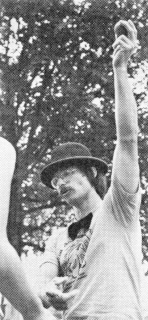Teaching
tip--- Learning 5 balls is an ordeal most of us eventually face. How
can you make it more fun and easier for your students? What techniques
have been found to be most effective for breaking through to a
sustained 5 ball cascade? Send in your own tips. Meanwhile, I'll list
a few which have worked for me or for others. Equipment---
Use solidly packed leather or cloth bean bags, tennis balls filled
with sand, "thunder balls" (tennis balls with 5 or six
ounces of shot inside) or dead lacrosse balls. Exercises
- Carlo suggests throwing successive 3 ball flashes with handclaps for
the missing balls. Right-Ieft-right-clapclap-left-right-left-(repeatJ.
Roger Dollarhide has two jugglers face each other about two feet
apart. Juggler ONE throws five balls to juggler TWO slowly. Juggler
TWO simply catches them all. S/he then throws them
back, picking up the tempo a bit. Eventually you can throw five balls
rapidly and accurately to the other person, with your fifth ball
leaving your hand just as the first ball lands in your partner's hand.
This exercise can lead directly to "take-aways" and to five
ball "flash passes", both good exercises for developing
speed and accuracy; the key to five (or more) balls. Sustaining
the juggle - If you count every throw aloud, you will probably speed
up the juggle. It is better to count every right hand throw at first,
says Peter Davison (eg. ONE--and-TWO--and-THREE--etc.). Eventually
you want to visualize and sustain the entire pattern, and counting may
become a hindrance. James Meltzer suggests running the pattern in your
mind constantly, even when you are not juggling. Also, you throw when
the descending ball has passed its peak, and is about half-way to your
throwing hand, not when it peaks, as in most 2,3,or 4 ball patterns. Juggling
games
It
has been suggested that in Fargo we hold a workshop on juggling
games, including relay races, contests and "New Games". Send
in descriptions of your favorites. Here is mine:
Jolly
bal - I'm sure that this game has been played by other jugglers under
other names. It is easy to learn and fun for both participants and
spectators. It is like volleyball, except that we use two players and
five gymnastic balls which weigh about 1 lb. each, and measure 7
inches in diameter. The imaginary net stands
The
player serving has 3 balls, the receiving player has 2. The When
we teach juggling in schools we use this game as our finale to the
assembly program that starts off our teaching day. One game of 3, and
the kids really get excited cheering for their champion. Practice
Jolly Ball with soccer sized balls if gymnastic balls aren't
available, and we'll have a tournament in Fargo. Meanwhile, keep
spreading the joy of juggling!
SOUTH As
a new member of the IJA, I would like to tell you something about the
juggling scene in "way-out" South Africa. Until
a few years ago jugglers were very scarce in our country, but due to a
sudden interest we have at present quite a few good jugglers.
There
are only two big touring circuses here. The biggest one, Boswell-Wilkie,
books acts from all over the world. In this year's program they feature
a Spanish juggler, Alvarez Junior who specializes in club juggling and
the boomarang plates.
The
other, smaller, circus, Olympic, uses only local artists. I toured with
them last year as ringmaster and juggler.
They
do a lovely act with balls, rings, clubs, fire, blocks and some very
fine balancing. Olympic's manager, Les Norman, used to do a brilliant
juggling and rollo-bar act in circuses a few years ago but is too busy
now.
We
are lucky in South Africa to have Keith Anderson, who used to run a
circus school for youngsters at the Cape Town YMCA. He and some pupils
are now performing in European circuses.
The
best juggler from Keith's school is Charles Straun. He and his partner
Colin Underwood do a lovely act with juggling, unicycling and slack-wire
walking. Both are in the army now, but plan to join Keith in Europe when
they finish service.
In
Sasolburg in the Orange Free State, the manager of the local theatre,
Jannie Lindeque is a circus fanatic and has started
They
specialize in clubs, hats and unicycling. Within a few months one of the
youngsters who had never juggled before was juggling five clubs! This
little circus does only occasional shows in the vicinity.
In
Cape Town we find the polished cabaret juggler and magician, Chris
Welsh. He has worked all types of shows, including
William Victor, probably our country's greatest circus material collector, is a professor of Criminology and Sociology at the University of Fort Hare in the town of Alice on the Cape. He does a lot of shows, mainly as magician, but also features slapstick juggling and plate-spinning. |
